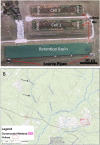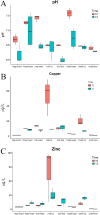Bioremediation of copper in sediments from a constructed wetland ex situ with the novel bacterium Cupriavidus basilensis SRS
- PMID: 36271237
- PMCID: PMC9587019
- DOI: 10.1038/s41598-022-20930-0
Bioremediation of copper in sediments from a constructed wetland ex situ with the novel bacterium Cupriavidus basilensis SRS
Abstract
The H-02 constructed wetland was designed to remove metals (primarily copper and zinc) to treat building process water and storm water runoff from multiple sources associated with the Tritium Facility at the DOE-Savannah River Site, Aiken, SC. The concentration of Cu and Zn in the sediments has increased over the lifetime of the wetland and is a concern. A bioremediation option was investigated at the laboratory scale utilizing a newly isolated bacterium of the copper metabolizing genus Cupriavidus isolated from Tim's Branch Creek, a second-order stream that eventually serves as a tributary to the Savannah River, contaminated with uranium and other metals including copper, nickel, and mercury. Cupriavidus basilensis SRS is a rod-shaped, gram-negative bacterium which has been shown to have predatory tendencies. The isolate displayed resistance to the antibiotics ofloxacin, tetracycline, ciprofloxacin, select fungi, as well as Cu2+ and Zn2+. Subsequent ribosomal sequencing demonstrated a 100% confidence for placement in the genus Cupriavidus and a 99.014% match to the C. basilensis type strain. When H-02 wetland samples were inoculated with Cupriavidus basilensis SRS samples showed significant (p < 0.05) decrease in Cu2+ concentrations and variability in Zn2+ concentrations. Over the 72-h incubation there were no significant changes in the inoculate densities (106-108 cells/ML) indicating Cupriavidus basilensis SRS resiliency in this environment. This research expands our understanding of the Cupriavidus genus and demonstrates the potential for Cupriavidus basilensis SRS to bioremediate sites impacted with heavy metals, most notably copper.
© 2022. The Author(s).
Conflict of interest statement
The authors declare no competing interests.
Figures







References
-
- Mustafa S, AlSharif M. Copper (Cu) an essential redox-active transition metal in living system–a review article. Am. J. Anal. Chem. 2018;09:15–26. doi: 10.4236/ajac.2018.91002. - DOI
-
- Shotyk W. Natural and anthropogenic sources of copper to organic soils: A global, geochemical perspective. Can. J. Soil Sci. 2020;100:516–536. doi: 10.1139/cjss-2019-0161. - DOI
-
- Kadlec, R. & Wallace, S. Treatment Wetlands. (2008).
Publication types
MeSH terms
Substances
Supplementary concepts
Grants and funding
LinkOut - more resources
Full Text Sources
Medical
Molecular Biology Databases

